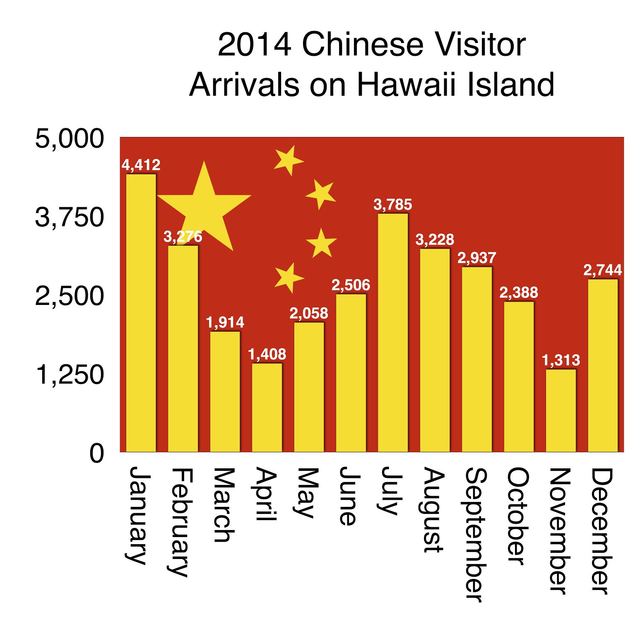The Chinese are coming. ADVERTISING The Chinese are coming. So say tourism officials, who are advising island businesses to prepare themselves to handle an influx of tourists who are expected to become one of the most important markets for Hawaii
The Chinese are coming.
So say tourism officials, who are advising island businesses to prepare themselves to handle an influx of tourists who are expected to become one of the most important markets for Hawaii businesses for the foreseeable future.
“There’s going to be, by 2020 … 200 million outbound travelers from China,” said Ross Birch, executive director of the Big Island Visitors Bureau. “The United States will capture about 10 percent of that 200 million, so we’re at 20 million going to the United States. Now, if Hawaii, as one of the premier destinations for the United States, captures 5 percent of those 20 million, we’re going to be at our exact number of visitors we get from Japan right now.”
The Japanese market — Hawaii’s biggest, making up more than 18 percent of all tourists — has taken between 20 and 25 years to mature, he said, allowing Hawaii’s infrastructure to grow to accommodate those visitors.
“Imagine our world transferring from today to 2020, and seeing just as many Chinese bodies as we’re seeing Japanese bodies on this island,” Birch said. “We’ve got a long ways to go before we catch up to the infrastructure we’ve already got set for the Japan market. … It’s exciting and it’s scary, all at the same time. You’ve been hearing ‘The Chinese, they’re coming, they’re coming, they’re coming, they’re coming.’ Now we’re starting to get to the critical mass point.”
In an effort to give island businesses a chance to start building that infrastructure, the Visitors Bureau and the Hawaii Tourism Authority held a special “Getting China Ready Seminar” on Friday to provide research and observations about Chinese visitors, what they’re looking for, and how best to cater to their needs.
So, how can area businesses attract and retain more Chinese visitors?
One surefire way is through language, said Ivy Gao, Hawaii Tourism Authority’s Hawaii Tourism China account director. Most young Chinese study English in school, but it is almost all focused on reading English, not speaking it.
“With Chinese tourists, most are still group-oriented,” she said. “Mostly because of the language barrier. They have to travel in a group, and the one leader who can speak English will lead them overseas. They enjoy doing things together, again, because of the language barrier. … We want to share, we want to communicate with the local people, but we can’t because of language.”
By providing itineraries, maps, marketing materials, websites, mobile apps and television commercials in Mandarin, tour operators and other services catering to Chinese visitors can make the experience easier and more welcoming, ensuring that they will receive good word of mouth — still an incredibly important tool to promote more international tourism, Gao said.
Offering more unique, Hawaii-made products for sale also is an important key to profiting from visitors.
Chinese tourists spent $422.9 million in Hawaii last year, and about half of that was on shopping, Gao said.
“Shopping. We do a lot of shopping,” she said. “I think most are in Oahu, but beside luxury brands, what else? What can we do? Chinese people like ‘Made in Hawaii,’ which means when they do the shopping at the shopping mall, they pick up things they look at them and they say, ‘Made in China.’ ‘Oh, no, I don’t want. I want something made in Hawaii.’”
Chinese tourists have gotten a bit of a bad rap when it comes to meals, as they are known for not being terribly adventurous, Gao said. But that is beginning to change.
“Chinese like food. And we want to enjoy Western food as well, but the English menu is totally hard to understand. If you can’t easily translate it, maybe just put a picture,” she said. “… You have to let them know what you have, and how to order, and then they will definitely enjoy it.”
Other tips include:
— Get to the point. The typical Chinese tourist is very busy and doesn’t have much time, so don’t waste it.
— In communicating with clients, doing so face-to-face and in Chinese is best.
— Chinese aren’t used to tipping, so be helpful and show them how.
— China is not a single market. Understand the regional and demographics differences.
— Show respect for Chinese culture.
— Keep up to date on developments. China changes quickly.
— Think about long-term engagement and commitment. Work to build friendships and trust.
— Try to say their names. If they don’t have an English name, just use their family name.
Email Colin M. Stewart at cstewart@hawaiitribune-herald.com.



